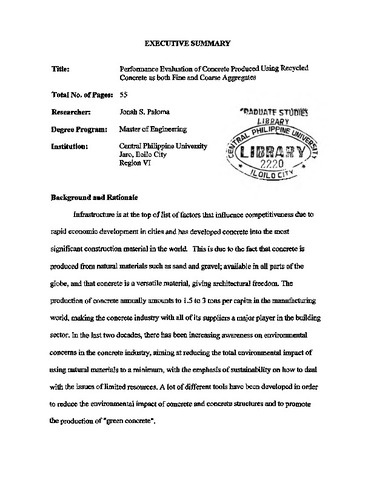Performance evaluation of concrete produced using recycled concrete as both fine and coarse aggregates

Page views
1,691Petsa
2010May-akda
Tagapayo ng Tesis
Tagapangulo ng Panel ng Depensa
Magbahagi
Metadata
Ipakita ang buong tala ng item
Abstract
Infrastructure is at the top of list of factors that influence competitiveness due to rapid economic development in cities and has developed concrete into the most significant construction material in the world. This is due to the fact that concrete is produced from natural materials such as sand and gravel; available in all parts of the globe, and that concrete is a versatile material, giving architectural freedom. The production of concrete annually amounts to 1.5 to 3 tons per capita in the manufacturing world, making the concrete industry with all of its suppliers a major player in the building sector. In the last two decades, there has been increasing awareness on environmental concerns in the concrete industry, aiming at reducing the total environmental impact of using natural materials to a minimum, with the emphasis of sustainability on how to deal with the issues of limited resources. A lot of different tools have been developed in order to reduce the environmental impact of concrete and concrete structures and to promote the production of "green concrete".
Improvement or rehabilitation of older or ageing infrastructure is also given importance and that includes the demolition of the existing structure to be replaced by a new one. Demolished materials should be utilized productively and should not add to the problem of environment Demolished concrete is one of the recyclable materials but some debris gleaned from demolition sites are left piled on the roads and causes environmental hazard; some are transported to municipal landfill and minimizes the area where fast growing population could build their houses for; and some are additional waste and causes problem on solid waste disposal. Substitution of waste materials in concrete will conserve diminishing resources, and will avoid the environmental and ecological damages caused by quarrying and exploitation of the raw materials for making concrete. To some extent, it will help to solve the problem otherwise encountered in disposing of the wastes.
Concrete may be defined as mixture of water, cement or binder, and aggregates, where the water and cement or binder form the paste and the aggregates form the inert filler. In absolute volume terms the aggregate amounts to 60-80 percent of the volume of concrete and is, therefore, the major constituent (Majid, 2000). The aggregate type and volume influences the properties of concrete, its mix proportion and its economy. Conventional concrete aggregate consists of sand (fine aggregate) and various sizes and shapes of gravel or stones (coarse aggregate). Recycled waste materials such as plastic, glass and recycled concrete are potential substitutes as alternative fine and coarse aggregate materials. Tests are needed to be performed in order to investigate the mechanical properties and durability characteristics of the concrete containing recycled constituents.
The essential requirement for an aggregate for concrete is that it remains stable within the concrete and in the particular environment throughout the design life of the concrete. The characteristics of aggregate must not affect adversely the performance of the concrete in either the fresh or hardened state. Aggregate parameters such as hardness, strength, and durability are known to be important for engineered-use concrete. The aggregate must be "clean," without absorbed chemicals, clay coatings, and other fine materials in concentrations that could alter the hydration and bond of the cement paste. These potential aggregates are to be evaluated on their compatibility with other materials, concrete properties and economy. Successful utilization of waste material as aggregate depends on ensuring that the properties of concrete will remain unchanged.
There is a growing interest in substituting alternative aggregate materials, largely as a potential use for recycled materials. Significant research has been done on many different materials for use as alternative aggregate such as bagasse, plastic, glass, fiberglass, rubber, coconut and palm kernel shells, and recycled concrete. Compressive strength and modulus of elasticity of concrete containing recycled fine aggregate are lower than in concrete containing sand. Substitution of sand for the fines of recycled concrete aggregates does not result in improved strengths. They are used to a limited extent and require some processing.
There are lots of information gaps that need to be answered. Among these are the compressive strength of the concrete containing recycled concrete as both fine and coarse aggregates, how is it compared to the compressive strength of conventional concrete, and
what are the characteristics of concrete using recycled concrete as both fine and coarse aggregates. It is for these reasons that this study is proposed.
Objectives of the Study
This study was conducted to test and evaluate concrete produced using recycled concrete as both fine and coarse aggregates.
Specifically, this study aimed:
1. To test and evaluate the concrete produced using the conventional and recycled concrete aggregates in terms of the following:
a. workability;
b. compressive strength; and,
c. flexural strength
2. To compare the concrete produced using the conventional and recycled concrete aggregates in different proportions.
3. To determine the acceptability of the concrete produced using recycled concrete aggregates in different proportions.
4. To determine the applicability of the concrete produced using recycled concrete in an infrastructure.
Paglalarawan
Abstract only
Mungkahing Sipi
Paloma, J. S. (2010). Performance evaluation of concrete produced using recycled concrete as both fine and coarse aggregates (Unpublished Master's special paper). Central Philippine University, Jaro, Iloilo City.
Uri
Special paperMga Paksa
Kagawaran
School of Graduate StudiesDegree
Master in EngineeringLokasyon ng Istante
GSL Theses 620.0072 P186
Pisikal na paglalarawan
55 leaves

